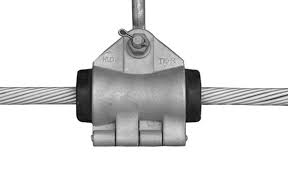
Distributed energy resources (DERs) refer to small-scale technologies for energy generation and storage situated near the location of use. This encompasses solar panels, wind turbines, and battery storage. These DERs enable enhanced energy management and ease the shift to a decentralized energy grid. The expansion of distributed energy resources is driven by elements like renewable energy sources, rising demand, and an emphasis on sustainability. Their advancement and evolution provide enhanced energy security, diminished reliance on fossil fuels, and greater grid adaptability. In nations across South America such as Brazil, Chile, and Argentina, DERs ease grid integration and contribute to a robust energy future. DERs offer the potential for energy equity and environmental sustainability across South America. A suspension clamp ensures the stability and dependability of power lines in DERs.
Suspension clamp firmly holds and suspends overhead power lines utilized in the DER infrastructure. A suspension clamp evenly distributes the load of the power cable to avoid stress on the conductor and supporting structures. This guarantees that the cables stay secure during bad weather conditions. The clamps can also keep a space between the conductors and lower the chance of electrical short circuits. Suspension clamps enable the expansion and contraction of power cables, thereby avoiding excessive stress. Furthermore, the clamp links the power cables from solar panels and wind turbines to the primary power grid. This article explores the various functions of suspension clamps in the evolution of distributed energy resources within South America.
Importance of a suspension clamp in distributed energy resources in South America
A suspension clamp is crucial for the infrastructure of distributed energy resources in South America. It ensures the stability and dependability of power lines, which include both new installations and existing infrastructure. A suspension clamp facilitates the energy shift by ensuring the safe and effective movement of renewable energy. The following are the functions of a suspension clamp in South America’s DERs.

- Long-distance energy transmission – suspension clamps hold conductors to utility poles while preventing stress on power lines. Considering the varied geography of South America, the clamps enable stable transmission throughout the area.
- Minimizing line sag – the suspension clamp can support the conductor’s weight and avoid sagging. This guarantees the power lines stay stable and minimizes contact with trees, structures, or the earth.
- Minimizing wear – a suspension clamp minimizes wear and tear on conductors and poles by evenly distributing mechanical stress. It also facilitates the use of setups by lessening stress on power lines.
- Flexibility in DER grid links – distributed energy resources link to local grids or microgrids. The suspension clamp provides more adaptable attachment points, making connections simpler.
- Lowering maintenance expenses and enhancing dependability – a suspension clamp requires minimal upkeep, which is crucial in isolated areas. Properly cared-for suspension clamps lower the chances of outages for a dependable grid.
Trends in decentralized energy sources in South America
The expansion of DERs in South America stems from rising energy demand, the need for enhanced energy access, and sustainability efforts. Many trends in DERs highlight the continent’s commitment to developing resilient energy systems. Developments in DER technologies position the region as a more decentralized, and resilient source of renewable energy. TTF is a world-class global provider of high quality overhead line hardware, transmission hardware, distribution hardware, conductors, insulators, cutout switches, anchoring and grounding products. Here are the typical trends seen in DERs across South America.

- Incorporation of energy storage systems – energy storage enables the collection of intermittent energy. For example, Chile and Argentina are putting money into storage solutions. This is to stabilize their renewable energy production.
- Decentralized initiatives – community-operated renewable energy endeavors are favorable for empowering local populations. They empower communities to control and handle their energy resources, which improves energy access.
- Integration of smart grid and IoT – the advancement of smart grids facilitates the inclusion of DERs into national grids. This enables a more efficient and adaptable energy distribution in the area. The grids use sensors and IoT technology to track and control energy distribution.
- Rural electrification and access to energy – DERs connect the communities that do not have dependable electricity. Their goal is to provide electricity to isolated regions to lessen energy poverty throughout the area.
- Energy-as-a-service (EaaS) models – this framework enables customers to use renewable energy systems such as solar panels. This lowers the significant initial expenses by making payments via a subscription or service charge.
